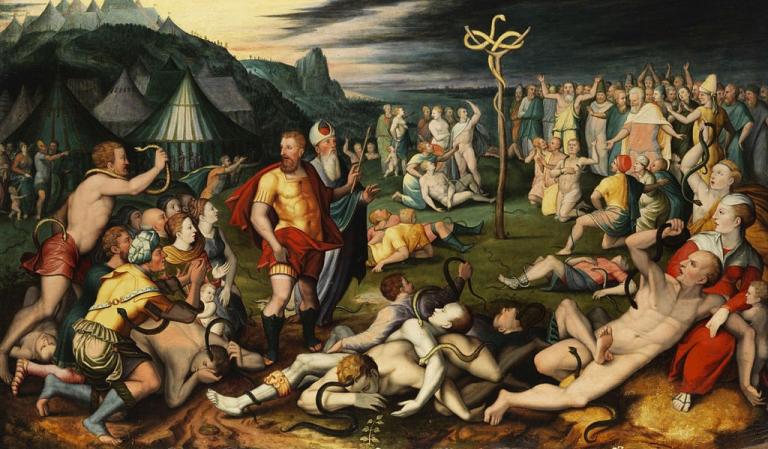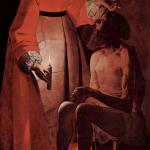Collect:
O God, who willed that your Only Begotten Son
should undergo the Cross to save the human race,
grant, we pray, that we, who have known his mystery on earth,
may merit the grace of his redemption in heaven.
Through our Lord Jesus Christ, your Son,
who lives and reigns with you in the unity of the Holy Spirit,
one God, for ever and ever.
Readings: http://www.usccb.org/bible/readings/091418.cfm
Preface:
It is truly right and just,
our duty and our salvation,
always and everywhere to give you thanks,
Lord, holy Father, almighty and eternal God.
For you placed the salvation of the human race
on the wood of the Cross,
so that, where death arose,
life might again spring forth
and the evil one, who conquered on a tree,
might likewise on a tree be conquered,
through Christ our Lord.

When we look at the Cross, what sign do we see? The Roman soldiers and the Pharisees meant it as a sign of punishment and shame. Indeed, penal theories of the meaning of the Cross abound in Christian writings as well. But the Liturgy of the Exaltation of the Holy Cross casts the Crucifixion in a different light. Perhaps these understandings are not incompatible—it is often said Catholicism embraces a theology of “both/and.” In any case, the vision we are shown today, inspired by St. Helena’s finding of the True Cross, is a glorious and comforting one for those (like me) who recoil from any suggestion of the Crucifixion as being a manifestation of an angry God.
“The evil one, who conquered on a tree, might likewise on a tree be conquered.” Though coming relatively late in the day’s liturgy, this references the primordial events found in the opening pages of Scripture. It introduces the motif that are borne out through all of the readings and prayers of this day. The evil one, in the form of a snake, on a tree, disrupted the communion of God with His children created in His image and likeness, bringing death into the world. But as I’ve written elsewhere, death itself is not pure evil, but also functions as God’s merciful conclusion to a broken life. The principal evil is the corruption of our imago Dei and our enslavement to sin and concupiscence.
The second movement in this symphonic telling of salvation is the Old Testament reading. The sin of the Israelites was to complain against God and His appointed agent, Moses. This sin was really not that much different from Adam and Eve’s. God had provided good food to them—manna from heaven—but they wanted something else. They had fruit from every tree but one, but they wanted the one. They failed in gratitude toward their heavenly Father, and in trusting that what He provides is indeed, in His perfect wisdom, the best nourishment for their bodies and souls. So the snake reappears, biting them so that many died.
So God commands Moses to mount a symbol of a seraph serpent on a pole, a fore-sign of the Cross, “and if any who have been bitten look at it, they will live.” It is interesting to note that no real animal is ritually killed in order to obtain atonement here. Rather, salvation is granted through the gaze of faith. It is a return to recognizing the providence of God the Father that saves the Israelites from death.
In the third movement, Jesus explains to Nicodemus the meaning of this sign that is nearing its climax in the crucifixion.
And just as Moses lifted up the serpent in the desert,
so must the Son of Man be lifted up,
so that everyone who believes in him may have eternal life.
For God so loved the world that he gave his only Son,
so that everyone who believes in him might not perish
but might have eternal life.
For God did not send his Son into the world to condemn the world,
but that the world might be saved through him.
Again, this passage does not mention “sacrifice” of a substitutionary penal atonement kind. Rather, like the seraph, Jesus is lifted up on a tree as a sign, and everyone who believes in Him—that sign and what it signifies—may have eternal life. It is the sign of the Father’s infinite love for the world, that He would give His only Son. The sacrificial Lamb is neither a scapegoat sent into the hills nor an obliterated burnt offering, but sacrificed to be our true food and true drink. There is no greater providential gift than the very body and lifeblood of the Son of Man, to feed us and restore us to our glorious state as children of God. If we but believe that and receive it with gratitude, we will have life eternal. For we are given the sign of the Cross not for condemnation, but for the salvation of the whole world.
Finally, St. Paul recapitulates this presentation of Jesus’s sacrifice on the Cross as a free will offering of love by God Who chose to subject Himself to all the horror of our fallen humanity:
Rather, he emptied himself,
taking the form of a slave,
coming in human likeness;
and found human in appearance,
he humbled himself,
becoming obedient to death,
even death on a cross.
But what of this difference between the seraph mounted by Moses and Jesus mounted on the Cross—was not the seraph the sign of the Evil One and of death? It calls to mind II Cor. 5:21 “For our sake he made him to be sin who knew no sin, so that in him we might become the righteousness of God.” That is how profound God’s self-sacrifice is: not only to empty himself to take on human form, not only to suffer an excruciating and humiliating death, but to be made a symbol of sin and death itself, the very opposite of His essence as the perfect I AM.
What depths of self-giving love and solidarity beyond all telling! How could we not look with wonder and faith and gratitude on this sign of the Cross? How could we not give deepest thanks for the bread from heaven that sustains us in daily life, as the manna did the Israelites?
Only if we do not see it, or have been taught to see something else when we gaze on the Cross. God forbid we fail in gratitude, and forbid it even more that we teach the little ones to see a distorted sign of the Cross, a symbol of an angry instead of loving God. We must see mercy and love, and teach others to see it too. As the psalm for the day says:
“But he, being merciful, forgave their sin
and destroyed them not;
Often he turned back his anger
and let none of his wrath be roused.”
May we know this mystery on earth—and teach it to others—that we may enjoy the grace of redemption in heaven. May we not fall for the Devil’s lie told on the primordial tree, that God our Father is anything but all generous, all trustworthy, and all loving. Let us look upon the Exaltation of the Cross and cry out:
We adore you, O Christ, and we bless you,
because by your Cross you have redeemed the world.












